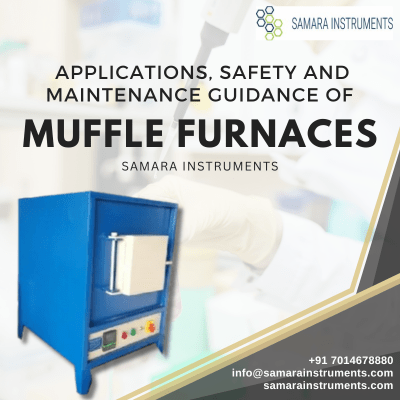Muffle Furnace – Applications, Safety & Maintenace
The concept of a muffle furnace encompasses a laboratory apparatus designed to subject substances to extremely elevated temperatures, all the while shielding them from the fuel and combustion byproducts that arise from the heat source. This isolation characteristic of muffle furnaces serves to curtail the potential for cross-contamination, facilitating the precise identification of distinct properties inherent to the materials.
Comprising two core components, a muffle furnace consists of the muffle itself and the furnace chamber. The muffle, a specialized chamber, is enveloped with materials highly resistant to heat, like firebrick or ceramic fiber. This muffle is nestled within the furnace chamber, the encompassing area. Various methods, encompassing electricity, gas, or oil, are employed to heat this furnace chamber.
The applications of muffle furnaces span a wide spectrum, encompassing:
- Ashing: The process of incinerating organic matter within a sample to leave behind exclusively inorganic constituents. This technique finds utility across diverse industries, including environmental testing, food science, and materials science.
- Heat Treatment: Characterized by subjecting materials to cycles of heating and subsequent cooling, heat treatment is wielded to modify material properties. Enhanced strength, toughness, and hardness of metals are the sought-after outcomes.
- Ceramics: Muffle furnaces are integral to the production of an array of ceramic goods, ranging from tiles and pottery to bricks.
- Glassworking: The muffle furnace’s role extends to fusing glass, generating enamel coatings, and performing soldering and brazing operations.
- Scientific Investigation: A staple in scientific inquiry, muffle furnaces underpin various research ventures, spanning mineral analysis to the exploration of material characteristics.
Safety Considerations with Muffle Furnaces
Given their capacity to achieve exceptionally high temperatures, adhering to safety protocols is paramount when working with muffle furnaces. Some critical precautions encompass:
- Protective Eyewear: Always wear protective eyewear when operating a muffle furnace.
- Appropriate Load: Avoid overloading the furnace with materials.
- Cautious Furnace Access: Refrain from opening the furnace door while it remains at elevated temperatures.
- Complete Cooling Period: Allow the furnace to cool down entirely before initiating any cleaning activities.
Maintenance Guidelines for Muffle Furnaces
Routine maintenance is vital to guarantee the secure and efficient operation of muffle furnaces. Tasks integral to maintenance encompass:
- Thorough Cleaning: Regularly clean both the muffle and the furnace chamber.
- Heating Element Assessment: Periodically inspect heating elements for signs of damage.
- Lubrication: Ensure that all movable parts are appropriately lubricated.
- Gasket Replacement: As required, replace gaskets to maintain proper functionality.
In Conclusion
In the realm of laboratory equipment, the muffle furnace emerges as a versatile and indispensable tool. Its applications span diverse domains, from ashing and heat treatment to ceramics production, glassworking, and scientific research. Given the potential for reaching exceedingly high temperatures, prioritizing safe usage and consistent maintenance is of the essence.
This discourse aims to shed light on the nuances of muffle furnaces. Should you harbour any further inquiries, please do not hesitate to reach out.


